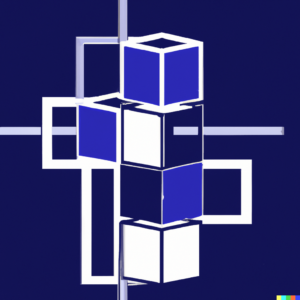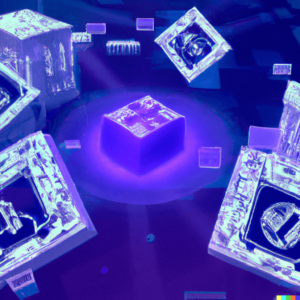By Bekkah Frisch, Marketing Executive
To understand what a smart contract is, you first need a basic primer on the history of the internet, which started in the 1960s with the military’s use of ARPANET. Just under 30 years later, the worldwide web started to see adoption from the wider public in a read-only environment we now think of as Web 1.0. The creation of Myspace, Facebook, and other social networks in the early 2000s led to the second iteration of the internet, known as Web 2.0. Today, early adopters of Web 3.0 are building a decentralized version of the internet based on transparency, security, and ownership of one’s own content.
Smart contracts enable much of the functionality of Web 3.0 by automating transactions and removing the need for trust between the two transacting parties. In the decentralized finance (DeFi) sector, this technology has been used to automate loan contracts without the need for a bank to act as a trusted intermediary. While this may be the most common application of smart contracts, the principle of smart contracts allows for incredible flexibility around any sort of data or asset transfer, including in gaming, record-keeping, social interactions, and beyond.
The first smart contract was deployed on Ethereum blockchain in 2015, but the concept was developed long before the blockchain technology existed to implement it. In 1994, Nick Szabo wrote a book titled, “Smart Contracts: Building Blocks for Digital Free Markets”. Szabo held that, based on their automation and lack of trust required between parties, smart contracts could help mitigate fraud, as well as reduce arbitration and enforcement costs.

Smart contracts enable much of the functionality of Web 3.0 by automating transactions and removing the need for trust between the two transacting parties. In the decentralized finance (DeFi) sector, this technology has been used to automate loan contracts without the need for a bank to act as a trusted intermediary. While this may be the most common application of smart contracts, the principle of smart contracts allows for incredible flexibility around any sort of data or asset transfer, including in gaming, record-keeping, social interactions, and beyond.
The first smart contract was deployed on Ethereum blockchain in 2015, but the concept was developed long before the blockchain technology existed to implement it. In 1994, Nick Szabo wrote a book titled, “Smart Contracts: Building Blocks for Digital Free Markets”. Szabo held that, based on their automation and lack of trust required between parties, smart contracts could help mitigate fraud, as well as reduce arbitration and enforcement costs.

So, How do Smart Contracts Work?
Smart contracts are built using code (or decentralized apps, known as dApps, in certain cases) to automate conditional functions. Solidity or Vyper are the coding languages typically used to create a smart contract, though developers can also choose to use Yul, Yul+, or Fe—an emerging smart contract language that is still under construction.
A simple smart contract may transfer payments from one smart wallet to another on an agreed-upon payment schedule, with the final payment releasing a tokenized title or tokenized real-world or digital collateral from the seller’s crypto wallet to the loan recipient’s wallet. Others may transfer assets after being signed by a majority of required signatories, who are identified by wallet address in the code of the smart contract.
There are three main variables associated with smart contracts:
- The transacting parties
- Type of assets to be exchanged
- Terms and conditions of transactions
Because Web 3.0 is still in its early stages of adoption, there are some limitations on smart contract usage. Smart contracts are not yet recognized as legally enforceable, which prevents large-scale adoption by heavily regulated institutions. Additionally, more complex contracts which rely on interpretation of phrases such as “in good faith” or “acts of God” are currently beyond the power of smart contracts to automate.
Smart contract conditions can also be difficult to change once the asset has been deployed on the blockchain, complicating ongoing contracts whose terms change on a regular basis.

What’s the difference between Smart Contracts and Blockchain?
Blockchain is a type of public, distributed ledger technology (DLT), which allows anyone to access records of transactions made on that particular blockchain. Smart contracts are stored on the blockchain, with automated transactions pushed out whenever contract conditions are met.
If we think of the blockchain as an Excel spreadsheet, then smart contracts would be the formulas that process various bits of information stored inside that document. Different blockchains, just like different Excel spreadsheets, contain different data and interacting formulas, which may alter the way the smart contract is interpreted. New information is constantly being entered into the blockchain, which can trigger new actions from the smart contract over time. However, smart contract actions cannot be triggered by just anyone—the wallet addresses which can trigger an update must be specifically listed in the contract. This allows contracts to remain transparent while also maintaining security.
Interactions that take place between blockchains are also possible. This would allow an authorized wallet address on, say, Polygon, to trigger a smart contract that is stored on Ethereum. To accomplish this, however, requires software known as cross-chain bridges. Bridging software has historically been vulnerable to hacking. To prevent hacking-related losses from bridging blockchains, most smart contracts are written and deployed exclusively on the Ethereum blockchain.

Ethereum and Smart Contracts
The Bitcoin blockchain was designed from the start to support finance transactions, so how did Ethereum emerge as the blockchain of choice for smart contracts? The blockchain boasts one of the largest developer communities and, in September 2022, Ethereum successfully transitioned from Proof-of-Work (PoW) to Proof-of-Stake (PoS) in an update known as The Merge—which reduced the chain’s environmental impact by 99.95%. But Ethereum was the most common choice even before then.
Let’s take a look at the structural reasons Ethereum is the most popular blockchain for smart contracts. First, the transaction speeds have long been much faster than Bitcoin and other blockchains. Each Bitcoin transaction needs six verifications from miners before being added to the blockchain—a process which typically takes over an hour per transaction. While a faster process than similar fiat transfers between banks or across borders, the process is too slow for the vast number of transactions required to execute smart contracts with multiple conditions, any of which must fire when triggered by other transactions processed on the blockchain.
By comparison, before The Merge, Ethereum managed 10-20 transactions per second (TPS). After the transition to Proof-of-Stake and the expected addition in 2023 of another technology known as sharding, the blockchain will be able to process 20,000 or more TPS. Although transaction fees are still a prohibitive aspect to conducting business on Ethereum, The Merge greatly reduced these costs (known in the community as “gas fees” or “gas”).
Blockchains like Solana and Cardano have been touted as “Ethereum killers” for innovations and improvements over the technological framework behind Ethereum. Innovations on Solana have focused on reducing environmental impact, lower transaction fees, and improved transaction speed, mainly by using a validation method known as Proof-of-History (PoH). This process allows multiple blocks to be verified at once, by multiple nodes. Polkadot stands out as unique in its protocols for protecting cross-chain activity from hacking—a benefit known as interoperability. But the developer community and customer base for these chains are still much smaller than for Ethereum.
Ethereum was designed to store information on-chain from the start and has the strongest community built around smart contract development. Bitcoin’s new Ordinals, which are NFTs inscribed on satoshis (the smallest denomination unit of Bitcoin), seek to capitalize on the chain’s community to erode Ethereum’s strong community advantage. Other blockchains are exploring new technologies like Proof-of-History to push the limits of transaction speeds and lower costs. Although nothing in crypto is guaranteed, the benefits Ethereum has been building out in total have so far helped protect Ethereum’s position as the most popular blockchain for smart contracts.

Current Uses of Smart Contracts
Contemporary use cases for smart contracts are mainly focused on decentralized finance, or DeFi, and the power of automated functions to enable trustless, transparent transactions on the blockchain.
Smart contracts are also an integral part of digital collectibles (also known as NFTs), as they contain the conditions and terms that make each collectible unique. This enables functionality like turning each digital collectible into a unique key to unlock exclusive features, digital assets, and access real-world rewards. Tiffany’s NFTiff products, for example, are available only to verified CryptoPunk holders. With only 250 physical pendants made, and each one paired with its own NFT, every piece of the innovative set has massive value for collectors, and that value will only increase over time.

What Else Can You Do with Smart Contracts?
The functionality doesn’t stop at NFTs or DeFi, though these are the two avenues which have led in adoption of smart contract technology.
For brands interested in pioneering their approach to marketing, smart contracts could be used to unlock access to exclusive content, a practice known as token-gating, or offer unique rewards for co-creation, submit to and/or vote on design contests that have been deployed on the blockchain, or other innovative types of engagement with a brand based on Web 3.0’s values of community, transparency, and ownership.
There are many applications which smart contracts can be used to automate that have yet to be explored. For example, smart contracts can also be used to provide verifiable tracking of a manufacturer’s supply chain, providing proof of a supply chain free of child labor, for instance, or the origin of ingredients in a skincare brand’s products.

Key Takeaways on Smart Contracts
Regardless of how brands decide to deploy smart contracts, the technology adds new levels of transparency and verification to processes that businesses and consumers engage in every day.
Brands may look to smart contract technology to add trust to social media, inspire new forms of engagement with customers, transform digital marketing strategies, trace the journey of their ingredients and products, or simply automate basic loans and asset transfers. No matter the path forward, the technology behind blockchain-based smart contracts offers a wide range of functionality that will power the next evolution of the internet.




